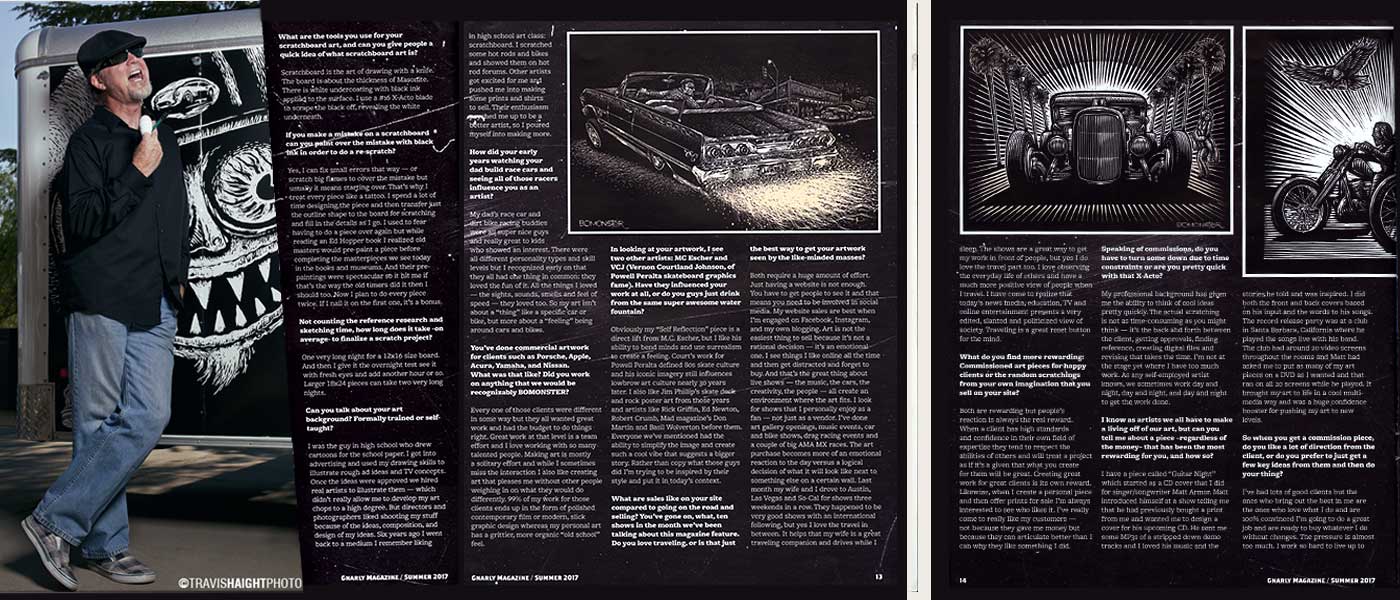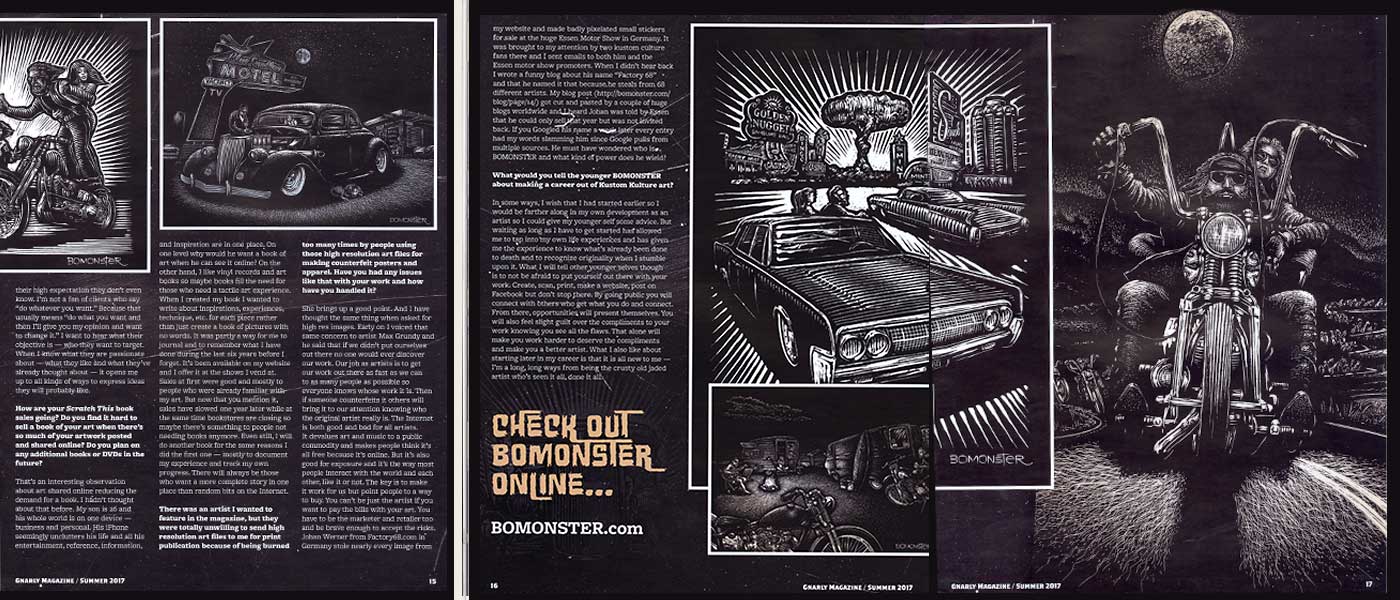BOMONSTER gets Gnarly

When Johnny VonGnarly asked permission to use my "Self Reflection" piece on the cover of his new magazine I didn't say no but I didn't say yes. Artists are always asked for free use of their work using the rationale that the promotional value will somehow favor the artist. The perceived value is always overestimated and the intended usage doesn't always reflect well. But Johnny's reason was simple enough: "I just like it." The he sent me a sample mockup of what he had in mind and I thought "I'd buy that magazine."
I said yes and his first issue of Gnarly Magazine turned out rad. And then sold out. He's gone on to create 9 more and is gaining the respect and a reputation for showcasing the best of the lowbrow kustom kulture. Just because he likes it.
My BOMONSTER art was showcased inside along with an in-depth interview. So I have the distinction of having my art featured on the premiere cover which I now rationalize as a great promotional value.
Here are excerpts from that interview...

The Gnarly Magazine Interview:
BOMONSTER is a Southern California scratchboard artist inspired by the hot rod/motorcycle/off-road/beach culture of independence, freedom and good times. His unique designs are scratched with a knife on a black-inked board to reveal the slightly twisted image just beneath the surface.
“I grew up in the So-Cal suburbs watching my dad build race cars at night and drag race on weekends. My friends and I all were into skateboards, BMX bikes, and dirt bikes. I met Ed “Big Daddy” Roth as a kid through my dad’s business and remember how his hot rod monster art captured the emotional spirit of those days like nothing else. We still live in a creative and fun time, and I try and tap into that same spirit of originality with my own art” says BOMONSTER.
If you make a mistake on a scratchboard can you paint over the mistake with black ink in order to do a re-scratch? Yes, I can fix small errors that way but If I don’t like the direction a piece is going, I start over. That’s why I treat every piece like a tattoo. I transfer just the outline shape to the board for scratching and fill in the details as I go. If I nail it on the first one, it’s a bonus.
Not counting the reference research and sketching time, how long does it take -on average- to finalize a scratch project? One very long night for a 12x16 size board. And then I give it the overnight test to see it with fresh eyes and add another hour or so. Larger 18x24 pieces can take two very long nights.
Can you talk about your art background? Formally trained or self-taught? I was the guy in high school who drew cartoons for the school paper. I got into advertising and used my drawing skills to illustrate rough ad ideas and TV concepts. Once the designs were approved, we hired real artists to illustrate them — which didn’t really allow me to develop my drawing skills. A few years ago I went back to a medium I remember loving in high school art class: scratchboard. I scratched some hot rods and bikes and showed them on hot rod forums. Other artists got excited for me and pushed me into making some prints and shirts to sell. Their enthusiasm psyched me up to be a better artist, so I poured myself into making more.
How did your early years watching your dad build race cars and seeing all of those racers influence you as an artist? My dad’s race car and dirt bike buddies were all super nice guys and great to kids who showed an interest. I recognized early on that they all had one thing in common: they loved the fun of it. All the things I enjoyed — the sights, sounds, smells and feel of speed — they loved too. So my art isn’t about a “thing” like a specific car or bike, but more about a “feeling” being around cars and bikes.
In looking at your artwork, I see two other artists: MC Escher and VCJ (Vernon Courtland Johnson, of Powell Peralta skateboard graphics fame). Have they influenced your work at all, or do you guys drink from the same super awesome water fountain? Obviously, my “Self Reflection” piece (on the magazine cover) is a direct lift from M.C. Escher, but I like his ability to bend minds and use surrealism to create a feeling. Court’s work for Powell Peralta defined 80s skate culture, and his iconic imagery still influences lowbrow art culture nearly 30 years later. I also like Jim Phillip’s skate deck and rock poster art from those years and artists like Rick Griffin, Ed Newton, Robert Crumb, Mad magazine’s Don Martin and Basil Wolverton before them. Everyone we’ve mentioned could simplify the image and create such a cool vibe that suggests a bigger story. Rather than copy what those guys did I’m trying to be inspired by their style and put it in today’s context.

What do you find more rewarding: Commissioned art pieces for happy clients or the random scratchings from your own imagination that you sell on your site? Both are rewarding but people’s reaction is always the real reward. When a client has high standards and confidence in their own field of expertise they tend to respect the abilities of others and will treat a project as if it’s a given that what you create for them will be great. Creating great work for great clients is its own reward.
Likewise when I create a personal piece and then offer prints for sale I’m always interested to see who likes it. I’ve really come to really like my customers – not because they gave me money but because they can articulate better than I can why they like something I did.
What would you tell the younger BOMONSTER about making a career out of Kustom Kulture art? In some ways I wish that I had started earlier so I would be farther along in my own development as an artist so I could give my younger self some advice. But waiting as long as I have to get started has allowed me to tap into my own life experiences and has given me the experience to know what’s already been done to death and to recognize originality when I stumble upon it. What I will tell other younger selves though is to not be afraid to put yourself out there with your work. Create, scan, print, make a website, post on facebook but don’t stop there. By going public you will connect to others who get what you do and connect. From there opportunities will present themselves. You will also feel slight guilt over the compliments to your work knowing you see all the flaws. That alone will make you work harder to deserve the compliments and make you a better artist.
What I also like about starting later in my career is that it is all new to me - I’m a long, long ways from being the crusty old jaded artist who seen it all, done it all.
